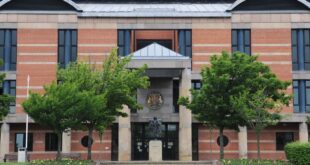Martin Lewis’ Money Saving Expert has told UK households to ‘stock up now’ on £1.65 essential in time for Christmas.
Royal Mail has confirmed from Monday October 7, the price of standard first-class stamps will rise by 30p to £1.65. While the price of sending a large first-class letter will go up by 50p, to £2.60.
Martin Lewis, founder of MoneySavingExpert.com, said: “For years, every time stamps go up in price I’ve suggested people stock up and bulk-buy in advance, as provided the stamp doesn’t have a price on it and instead just says the postage class, it’s still valid after the hike. So you may as well stock up now, even if it’s just for Christmas cards for the next few Christmases.”
READ MORE: ‘Most expensive’ supermarket now cheaper than Aldi and Lidl after 15% price cut on shopping essential
The MSE website also urged buyers to be careful of buying fake stamps by buying from reputable high street outlets and hanging onto your receipt. Stamps are also available to buy directly from the Royal Mail online shop.
“In April, Royal Mail paused the £5 penalty for anyone who receives a letter with a fake stamp on it while it takes fresh action against counterfeits. However, you may still be charged if you use a counterfeit stamp when sending something. To check if a stamp is genuine, you can use Royal Mail’s new ‘fake stamp scanner’,” the MSE website advises.
In addition to the first-class stamps price increase, many of Royal Mail’s ‘Signed For’, ‘Special Delivery Guaranteed’ and ‘Tracked’ services will also go up in price, as will the cost of sending parcels by first and second class. However the price of sending second-class standard and large letters will remain the same.
Royal Mail said it had to increase the price of stamps due to the “urgent” financial challenge it faces. Nick Landon, Royal Mail’s chief commercial officer, said: “We always consider price increases very carefully.
“However, when letter volumes have declined by two-thirds since their peak, the cost of delivering each letter inevitably increases.
“A complex and extensive network is needed to get every letter and parcel across the country for a single price – travelling on trucks, planes, ferries and in some cases drones before it reaches its final destination on foot. We are proud to deliver the universal service, but the financial cost is significant.
“The universal service must adapt to reflect changing customer preferences and increasing costs so that we can protect the one-price-goes anywhere service, now and in the future.”
Royal Mail said letter volumes have fallen from 20 billion in 2004/5 to around 6.7 billion a year in 2023/4, so the average household now receives four letters a week, compared to 14 a decade ago.
The number of addresses Royal Mail must deliver to has risen by four million in the same period meaning the cost of each delivery continues to rise.
Swapping non-barcoded stamps
MSE also urges people to swap older non-barcoded stamps they may have been hanging on to. In July 2023, the Royal Mail scrapped everyday non-barcoded stamps – the ones featuring a profile of the Queen’s head.
The non-barcoded stamps are no longer valid, but they can be exchanged via the Royal Mail’s ‘Swap Out’ scheme. However, there’s no need to swap Christmas stamps or ‘special’ stamps with pictures on as they can still be used.
You can find out more on Royal Mail’s ‘Swap Out’ scheme on their website.
Join our WhatsApp Top Stories and, Breaking News group by clicking this link



